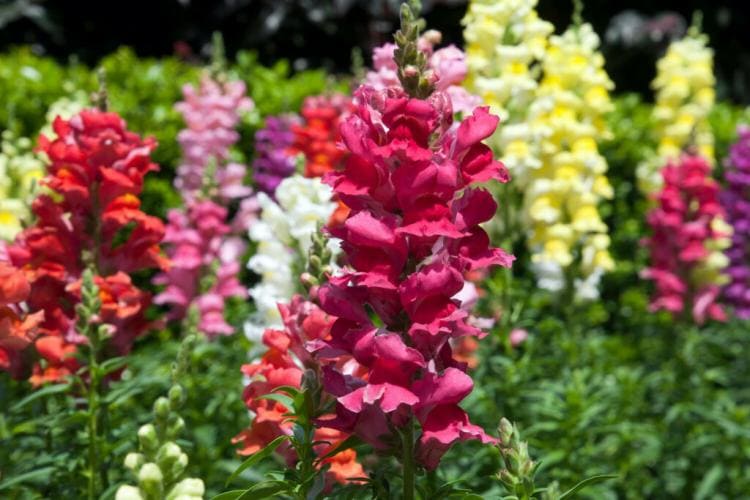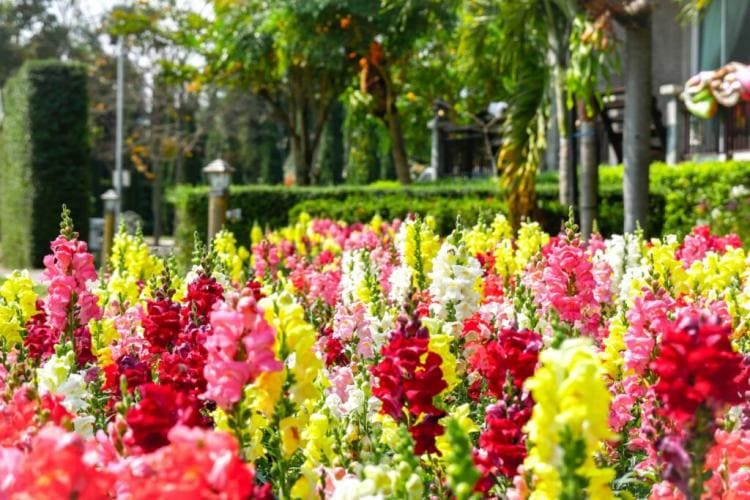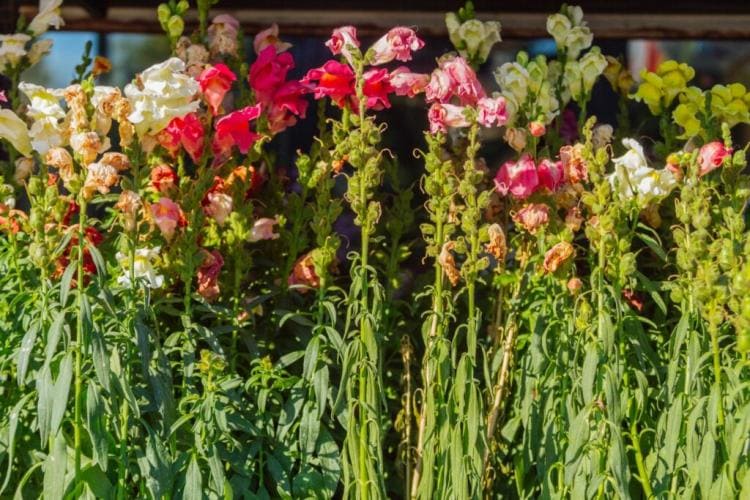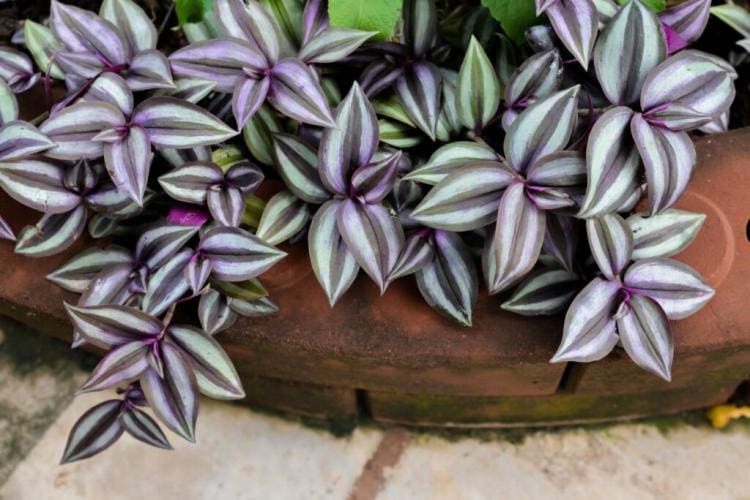Snapdragons: location, care & flowering time
The snapdragon enjoys continued popularity in cottage gardens and flower meadows. How it is properly planted, cared for and propagated, learn from this article.

Snapdragons have a wide range of flower colors [Photo: demamiel62 / Shutterstock.com]
In addition to marigolds, dahlias and peasant roses, the snapdragon ( antirrhinum ) is an integral part of the peasant garden. The large flower is a focal point for bees and bumblebees, but the snapdragon is also suitable as a cut flower.
Snapdragons: flowering time, origin and characteristics
Table of Contents
The snapdragons are a genus of the plantain family (Plantaginaceae). Their original home area includes the western Mediterranean and western North America. There the plant grows, among other things, in crevices and walls. The wild snapdragon is the snapdragon ( Antirrhinum majus ), also known as the garden snapdragon. In addition to the wild form, there are also some varieties that are planted as ornamental plants in the home gardens, often these are hybrid varieties. The snapdragon has a wide range of flower colors – there are white, yellow, pink or red varieties, but also snapdragons in shades of purple and blue. The snapdragon flowers stand alone or in racemose inflorescences and have a palate-like bulging lip on which the nectar collects. A colored spot on this lower lip is particularly characteristic. The snapdragon is a perpetually blooming summer flower that inspires with its splendor of colors from June to September. The snapdragon leaves are arranged opposite each other and have an egg-shaped to elongated-elliptical shape. In its home regions the snapdragon is perennial, but in our latitudes it is usually annual due to the colder winters.
Attention: There is a risk of confusion with Levkojen. They are also often planted in the cottage garden, but belong to the cruciferous family (Brassicaceae).

Snapdragons are a popular destination for bees and bumblebees [Photo: All for you friend / Shutterstock.com]
The best snapdragons for the garden
Most of the varieties of snapdragons available in stores are annual F1 hybrids, i.e. not single-variety, reproducible seeds. Offspring of these hybrids are very different from the mother plants, in particular the flowers of the next generation are much more inconspicuous. In the following we will therefore introduce you to the most beautiful wild forms.
Pygmy snapdragons ( Antirrhinum majus var. Pumilum ): The pygmy snapdragon is a ground cover and has blue-violet mini-flowers. These appear from July to September.
Spanish snapdragon ( Anthirrhinum hispanicum ): The Spanish snapdragon is native to Spain and has felty leaves. The flowers are white and pink.
Broad-leaved snapdragon ( Antirrhinum latifolium ): The broad-leaved snapdragon is hardy. It has creamy white to yellow flowers that appear from June to September.

Snapdragons grace parks and gardens [Photo: Ratchanee Sawasdijira / Shutterstock.com]
Plant snapdragons: sowing, location and Co.
The snapdragon is not hardy in our latitudes. However, once it has been planted, it often sows itself again after flowering and thus reappears in the years to come. The following information applies in particular to the garden snapdragon ( A. majus ), other species may prefer other conditions.
Location and substrate
The location of the snapdragon should be sunny and warm, but it can also flower in partially shaded locations. It is relatively undemanding when it comes to the choice of substrate, it can handle almost any garden soil. The snapdragon grows particularly well in nutrient-rich soil that is always kept moist. The substrate should have a pH between 5.5 and 6.5. Potting soil is suitable for cultivating snapdragons in pots or improving the garden soil. Our Plantura organic potting soil, for example, is suitable for growth in the tub, which contains a long-term nutrient store thanks to the compost it contains.
Plant snapdragons
You can sow snapdragons or plant snapdragons – both in the garden bed and in planters.
When sowing snapdragons, however, a few things must be observed. They can either be brought forward from January or planted directly outdoors from April. Snapdragons are cold germs, so they need a cold stimulus to germinate. Therefore, the seeds should be stored in the refrigerator for about a week before sowing. Then you can put them in a cold frame or on the windowsill in January / February. The seeds are placed on the substrate at a planting distance of three centimeters, but not pressed in. Since snapdragons are light germs, they must not be covered by earth – otherwise germination will not occur. The substrate should always be kept moist. At temperatures of 18 ° C, the time has come and the first shoots develop after 10 to 14 days. So that the plants can get used to the temperatures of the garden, they should be placed in a place with temperatures of 15 ° C two to three weeks after germination.

Snapdragons are frugal and can also grow in nutrient-poor locations [Photo: Anaelileana / Shutterstock.com]
From the middle of April you can plant your favorite or purchased snapdragons. A plant spacing of 10 to 15 cm is suitable. From June onwards, the first flowers will appear. If the seeds are sown outdoors in April, the snapdragon does not develop its flowers until later. If late frosts are announced, the snapdragons should be covered with fleece, but night frosts cannot harm them.
Snapdragon care: this is important to note
For a particularly beautiful bloom, some care measures can be carried out to support the snapdragon.
Water and fertilize snapdragons
For a long flowering period, snapdragons should be fertilized with a liquid fertilizer every 14 days. In this case, an organic liquid fertilizer such as our organic tomato and vegetable fertilizer is particularly recommended. This provides all the important nutrients for strong flowers throughout the summer season and healthy plant growth. It also contains beneficial microorganisms that support root growth and offers a lot of potassium, which should be available in large quantities for snapdragons.
Adding the right amount of water is part of caring for snapdragons. The snapdragon is poured as required. It does not tolerate waterlogging, but the soil should always be kept moist. The snapdragon protects itself from drought with its extensive roots.
Cut snapdragons
In spring, it's time to prune the snapdragons. To encourage branching, the shoots are cut off at a height of 10 cm. In addition, flower growth can be promoted by removing dead flowers. The individual flowers can either be plucked off or the entire stem can be removed at once.

If the snapdragons hang their heads, they suffer from a lack of water [Photo: Simon Mayer]
Tip: After flowering, the snapdragon seed pods form. Therefore, do not remove the flowers from all plants, but keep some for propagation.
Are snapdragons hardy?
Whether snapdragons are hardy depends on winter temperatures. In our part of the world, you usually don't survive winter. Large snapdragons ( Antirrhinum majus ) defy temperatures down to a maximum of -7 ° C. However, if they are overwintered frost-free, snapdragons can develop perennial flowers. To protect the snapdragon from the winter cold, you can, for example, put fir branches over the earth.
To multiply snapdragons
The snapdragon can easily be propagated with seeds. About six weeks after flowering, the seed capsules form on the stem, so dead flowers should not be removed. When immature, the seed pods are green; they are harvested when they are brown. You have to estimate the time exactly, because if you harvest too late, the seed pods are already open and all the seeds have fallen out. To avoid this, the seed pods should be checked every three days. If you have caught a good harvest time, the ripe seed pods are separated from the stem and the seeds are shaken out into a container. For this, you should choose a sunny day so that the seeds do not need to be dried. These should be stored in a dark and dry place over the winter. They can be sown the following spring.
Tip: When dry, the seed pods can look like snapdragon skulls. They are therefore ideal for use as Halloween decorations.

Ripe snapdragons seed pods [Photo: Furiarossa / Shutterstock.com]
Are snapdragons poisonous?
Snapdragons are not poisonous, they pose no danger to humans or animals.
Bellflowers, lady's mantle, peonies – they all have one thing in common: They are popular flowers in the farmer's garden. Check out our article for the best tips and tricks for creating a cottage garden.





